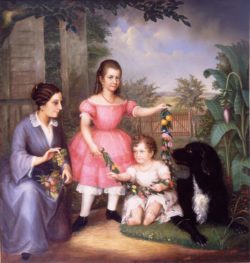William Rumpler
William Rumpler (born Johann Wilhelm) was a German portrait and landscape painter active in New Orleans between 1853 and 1866.

Courtesy of Louisiana State Museum
The Davidson Family at Poydras Plantation. Rumpler, William (Artist)
WArtist Johann William Rümpler was active in New Orleans between 1853 and 1866. He is known for his portraits depicting notable residents of the city. His existing paintings are often large in scale and characterized in style as “plantation baroque.” A number of his works are in the permanent collections of the Louisiana State Museum and The Historic New Orleans Collection.
Rümpler was born in Frankfurt, Germany, in 1824. Records indicate that he studied under German artist Jakob Becker, who himself was trained at the Düsseldorf Academy and became a professor at the Städel Institute in Frankfurt in 1840. Little is known of Rümpler’s early education and life in Germany, though he was likely among the many Germans who arrived in New Orleans during the immigration wave of the mid-nineteenth century. According to the 1853 New Orleans City Directory, Rümpler had a studio at 7 Gleise’s Row, Poydras. He would later be listed at studios located on Royal and Carondelet Streets in the late 1850s and into the 1860s.
Like many itinerant artists working in the city, Rümpler painted portraits of prosperous New Orleanians. By the time he began painting portraits in the city, monumental portraiture—which often included a detailed background behind the sitter(s)—was in vogue. One such portrait is that of prominent landowner and businessman John Davidson and his wife Henrietta’s children, The Davidson Family at Poydras Plantation (1858), which was formerly displayed in the family’s home on St. Charles Avenue. Davidson owned Poydras plantation, and his two children, along with their nurse, are depicted within the plantation grounds. The outdoor landscape also features prominently in his painting Amelia Scooler (Loewengardt) (1857). Scooler’s father, Maurice (1827-1900), also from Germany, was a notable importer, jeweler, and silversmith in New Orleans who created Mardi Gras krewe favors after the Civil War. Amelia later married silversmith Isaac Loewengardt. Rümpler’s contributions to the New Orleans art world are those of a painter experimenting with the boundaries of the canvas in both scale and content.
